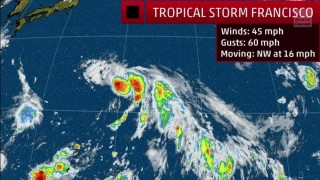Loading
Search
▼ Tropical Storm Francisco Expected to Hit Japan as Typhoon
- Category:Other
Residents of southern Japan are watching for a potential strike from Tropical Storm Francisco, which is expected to intensify into a typhoon as it moves northwest toward the island nation.
Francisco’s top sustained winds on Friday night local time were about 45 mph, according to the Joint Typhoon Warning Center (JTWC).
The storm was located some 660 miles east-southeast of Iwo Jima, moving northwest at about 12 mph.
Residents of southern Japan are watching for a potential strike from Tropical Storm Francisco, which is expected to intensify into a typhoon as it moves northwest toward the island nation.
Francisco’s top sustained winds on Friday night local time were about 45 mph, according to the Joint Typhoon Warning Center (JTWC).
The storm was located some 660 miles east-southeast of Iwo Jima, moving northwest at about 12 mph.
Typhoons in the Northwest Pacific are equivalent to hurricanes in the Atlantic and Northeast Pacific. Both names apply to tropical cyclones that have sustained winds of at least 74 mph.
This year has been uncommonly calm to date for typhoon activity in the Northwest Pacific, which is normally the most active region on Earth for tropical cyclones. The only typhoon recorded in 2019 so far was Wutip, the first Category 5 super typhoon on record in February. Wutip passed south of Guam and Micronesia as a Category 4 storm, producing more than $3 million in damage.
In JTWC records that go back to 1945, only one other year, 1998, has gone from the end of February to the beginning of August without any typhoons, as noted by Phil Klotzbach of Colorado State University.
In a typical season (1981-2010), the Northwest Pacific sees about eight named storms and five typhoons by Aug. 2. This year has brought just five named storms and one typhoon so far.
The amount of accumulated cyclone energy in the Northwest Pacific – which is calculated based on how strong tropical cyclones get and how long they last – was only a little over half of average for the year as of Aug. 2, according to data compiled by CSU.
Japan is accustomed to typhoons. In a typical year, three typhoons strike Japan, according to data from the Japan Meteorological Agency analyzed by nippon.com. Landfalls are most common in August, but the most destructive typhoons tend to be in September.
Another system in the Northwest Pacific, currently dubbed Invest 94W, could become a typhoon next week and may end up posing a threat to Japan as it heads mainly north and northwest.
Francisco’s top sustained winds on Friday night local time were about 45 mph, according to the Joint Typhoon Warning Center (JTWC).
The storm was located some 660 miles east-southeast of Iwo Jima, moving northwest at about 12 mph.
Residents of southern Japan are watching for a potential strike from Tropical Storm Francisco, which is expected to intensify into a typhoon as it moves northwest toward the island nation.
Francisco’s top sustained winds on Friday night local time were about 45 mph, according to the Joint Typhoon Warning Center (JTWC).
The storm was located some 660 miles east-southeast of Iwo Jima, moving northwest at about 12 mph.
Typhoons in the Northwest Pacific are equivalent to hurricanes in the Atlantic and Northeast Pacific. Both names apply to tropical cyclones that have sustained winds of at least 74 mph.
A Quiet Typhoon Season So Far
This year has been uncommonly calm to date for typhoon activity in the Northwest Pacific, which is normally the most active region on Earth for tropical cyclones. The only typhoon recorded in 2019 so far was Wutip, the first Category 5 super typhoon on record in February. Wutip passed south of Guam and Micronesia as a Category 4 storm, producing more than $3 million in damage.
In JTWC records that go back to 1945, only one other year, 1998, has gone from the end of February to the beginning of August without any typhoons, as noted by Phil Klotzbach of Colorado State University.
In a typical season (1981-2010), the Northwest Pacific sees about eight named storms and five typhoons by Aug. 2. This year has brought just five named storms and one typhoon so far.
The amount of accumulated cyclone energy in the Northwest Pacific – which is calculated based on how strong tropical cyclones get and how long they last – was only a little over half of average for the year as of Aug. 2, according to data compiled by CSU.
Japan is accustomed to typhoons. In a typical year, three typhoons strike Japan, according to data from the Japan Meteorological Agency analyzed by nippon.com. Landfalls are most common in August, but the most destructive typhoons tend to be in September.
Another system in the Northwest Pacific, currently dubbed Invest 94W, could become a typhoon next week and may end up posing a threat to Japan as it heads mainly north and northwest.
- August 3, 2019
- Comment (0)
- Trackback(0)


